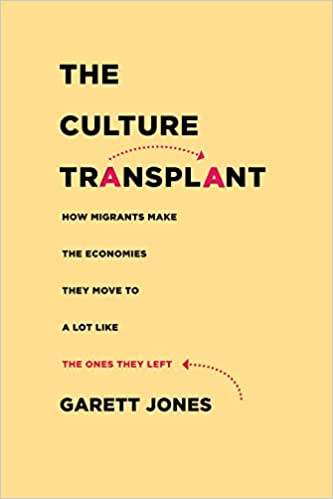Rejecting the Culture Transplant
By Arnold Kling


- A book review of The Culture Transplant: How Migrants Make the Economies They Move to a Lot Like the Ones They Left, by Garett Jones.1
In January of 2018, President Donald Trump disparaged taking in immigrants from “[expletive] countries.” Equally dramatically, albeit more politely, in the conclusion to his recent book, The Culture Transplant,1 Garett Jones writes:
- We can predict that year after year of massive immigration from the world’s poorest countries into the I-7, the world’s most innovative nations would eventually tend to have effects like these:
- The quality of government would fall; corruption would rise.
- Social conflict would increase—and so would the risk of civil war.
- Trust—and probably trustworthiness—toward strangers would decline.
- Support would rise for higher minimum wages and laws making it harder to fire workers. (p. 157)
Innovation would decline overall, and since new innovations eventually spread across the entire planet, the entire planet would eventually lose out.
Suppose that a big immigration wave from the world’s poorest countries to the richest countries does take place. What are the chances that this would “wound the goose that lays the golden eggs of global innovation and worldwide prosperity,” as Jones puts it?
Before reading The Culture Transplant, I would have said that there is about a 20 percent chance that the results would be so adverse. After reading the book, I would still rate the chances as about 20 percent. The methods used in the studies that Jones relies on to make his case are often clever and generally approved within the economics profession, but I cannot give them any weight at all.
As one example, Jones offers Argentina as the poster child for the harms of immigration:
- In 1913, thanks in large part to a vibrant export-oriented cattle industry, Argentina was a rich nation by the standards of the day. Average income per person in Argentina was 15 percent higher than in France and just 10 percent lower than in Germany. By 2016 by the same measure, France was 100 percent richer than Argentina, and Germany 140 percent richer. Argentina is a failed prodigy: great early promise, little accomplishment. (p.8)
Jones proceeds to cite historical accounts that attribute the failure of Argentina to radical movements that emerged within a large population of Italian and Spanish immigrants. But later in the book, Jones places great reliance on an indicator that measures the quality of a country as a source of immigrants based on its deep history, back to 1500 and further. This index for Italy is 82 out of 100, and for Spain it is 96. Those values make Italy and Spain two of the best countries you can find as sources of immigration. And by the method that the indexes are constructed, they would have been among the best in the late 19th century, when the immigration wave to Argentina took place.
The index primarily depends on an assessment of how close a country was to the technological frontier in 1500. Jones reports that studies using similar indices in cross-country regressions are useful at explaining differences in economic well-being. But I give very little credence to these sorts of cross-country regressions, for a number of reasons.
One objection I have is to the way that proxy variables are created and used. The term “culture” is rich and layered, with many possible meanings. Jones describes the all-important technology indicator as an index assembled by economists Diego Comin, William Easterly, and Erick Gong assessing each country’s use in 1500 of technology in agriculture, transportation, military, industry, and communications. For example, the communications measure is:
- … a mix of whether they use paper, whether they have books, and whether they have some systematic method for printing (p. 45-46)
In short, immigrants who come from countries that used these technologies in 1500 will have a high score on “culture.” It is asking a lot of a proxy variable to perform this work.
Another objection I have is that regressions make linear approximations to what may be nonlinear relationships. In an interview with population geneticist Razib Khan, Jones says, “So I guess I follow the macroeconomist’s approach of when in doubt, assume things are linear, and remember that the quest for nonlinear relationships will mostly lead you down rabbit holes and puzzles, rather than clear answers.”2
On page 51, there is a chart plotting a countries’ incomes in 2005 against their technology history scores. Visually, one can see a hockey stick. All but a few of the countries with indexes below 80 have low incomes. Almost all of the variation in incomes occurs among countries with indexes over 80, with a handful of very poor countries, a handful of very rich countries, and many middle-income countries. To “assume things are linear” is malpractice.
Big Questions, Big Answers
I think of the field of economic growth and development as one with big questions and big proposed answers. Some of the big questions are:
- • How did the United States and other countries become WEIRD (Western, Educated, Industrialized, Rich, and Democratic)?
- • Why did the Industrial Revolution take off when and where it did (Britain, primarily)?
- • Why between, 1500 and 2000, did Europe far outstrip China in economic development (“the great divergence”)?
- • Why did the Old World “discover” and then dominate the New World, rather than the other way around?
- • After World War II, why did some countries in Asia “catch up” rapidly with the industrialized West, while other countries in Latin America and Africa lagged?
Jones has been pursuing his own big question, which is why Singapore is one of the wealthiest nations on earth. He writes:
- This is the final book in my Singapore Trilogy. The trilogy began with Hive Mind, where the first country mentioned is Singapore, a nation that unsurprisingly combines high test scores, high average incomes, and high-quality governance. The second book, 10% Less Democracy, has an entire chapter on the lessons the world’s rich democracies can learn from Singapore, a nation with 50 percent less democracy than the U.S. And of course, Singapore—largely a nation of immigrants whose ancestors left southern China—illustrates cultural transplant theory. (p.161)
Economists have long debated the answers to the big questions. The candidates for big answers are:
- • Population genetics. Populations differ in terms of IQ, and IQ is correlated with income.
- • Geography and resources. Jared Diamond looked at the question of why the Old World conquered the New and gave the answer of Guns, Germs, and Steel. He argued that the Old World was blessed with resource advantages, such as horses, oxen, and other useful domesticated animals that were not present in the Americas before Columbus arrived.
- • Institutions. Many economists—most prominently Douglass North—argue that growth can be explained by institutions, particularly those that protect private property. These economists will cite North Korea and South Korea as examples of how different institutions lead to different outcomes in otherwise similar lands.
- • Cultural values. Other economists, most prominently Deirdre McCloskey, argue that prosperity requires a culture that approves of commerce and respects the merchant and the entrepreneur.
Jones argues against the geography-and-resources explanation. I think that most modern economists would agree with him. The profession has moved in the direction of emphasizing intangible factors.
In the first book in his “Singapore Trilogy,” Jones emphasized population genetics, notably national average IQ.3 IQ is not mentioned at all in The Culture Transplant. Does Jones have amnesia? Perhaps not. In the passage quoted above, the euphemistic reference to Singaporeans having “high test scores” suggests that he may be thinking that his conclusions are offensive enough already, without touching the third rail of IQ differences among populations.
The “technology history” variable that Jones emphasizes may be a subtle proxy for average IQ. But Jones instead tells us to treat it as a proxy for cultural values.
Although he no longer wants to talk about IQ, Jones continues to believe that institutions matter. In fact, his wariness of immigration from poor countries is based on a fear that they will eventually undermine the institutions that support markets and innovation.
If I were trying to make such a case, I would attempt to demonstrate that: (a) there are population groups in which cultural support for markets and innovation is weak, and these groups are inclined to support policies that restrict markets and innovation; and (b) that when immigrants arrive in a new country, these particular attitudes persist among immigrants and their descendants.
Instead of homing in on this, Jones picks some questions that others have asked in surveys about values, such as whether strangers can be trusted, and shows that the answers given by immigrants and by people of the countries of origin are often correlated, even among second- and later-generation immigrants. But I would wager that immigrants assimilate at different rates to different values. On some issues, traditions from the old country prevail. On other issues, immigrants absorb the new culture.
For more on these topics, see
- “Ideas Trigger Change,” by Lars Peder Nordbakken and Leonidas Zelmanovitz. Library of Economics and Liberty, Sep. 5, 2022.
 Ran Abramitzky and Leah Boustan on Immigration Then and Now. EconTalk.
Ran Abramitzky and Leah Boustan on Immigration Then and Now. EconTalk.- “Immigration and the Open Society,” by Alberto Mingardi. Library of Economics and Liberty, Sep. 6, 2021.
For the purpose at hand, when a man immigrates to the United States from a Communist country, the key question is whether he wants us to remain capitalist or become Communist. If, as I suspect, the typical immigrant wants us to remain capitalist, then we need not worry what other values from his home country he might continue to hold.
The Culture Transplant speaks to an important question concerning the risks of large-scale immigration. Jones has made a heroic effort to distill complex technical papers by economists into something that can be understood by an intelligent layman. Sadly, the research methods that those economists employ deserve, in my view, to be characterized by President Trump’s expletive.
Footnotes
[1] Garett Jones, The Culture Transplant: How Migrants Make the Economies They Move to a Lot Like the Ones They Left. Stanford Business Books, 2022.
[2] “Garett Jones: The Culture Transplant – How Migrants Make the Economies They Move To a Lot Like the Ones They Left,” by Razib Khan. Substack, Unsupervised Learning, Nov. 17, 2022. Gated podcast episode.
[3] Garett Jones, Hive Mind: How Your Nation’s IQ Matters So Much More Than Your Own. Stanford Economics and Finance, 2015.
*Arnold Kling has a Ph.D. in economics from the Massachusetts Institute of Technology. He is the author of several books, including Crisis of Abundance: Rethinking How We Pay for Health Care; Invisible Wealth: The Hidden Story of How Markets Work; Unchecked and Unbalanced: How the Discrepancy Between Knowledge and Power Caused the Financial Crisis and Threatens Democracy; and Specialization and Trade: A Re-introduction to Economics. He contributed to EconLog from January 2003 through August 2012.
Read more of what Arnold Kling’s been reading. For more book reviews and articles by Arnold Kling, see the Archive.
